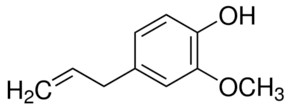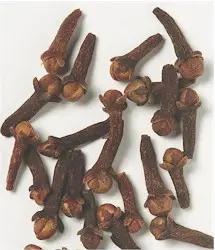Eugenol is a natural active ingredient of plant origin used in veterinary medicine mainly in dogs and cats against some external parasites (lice, fleas, flies, ticks, etc). It is also used against agricultural and household pests.
Common name: EUGENOL
Other names: 2-Methoxy-4-(prop-2-en-1-yl) phenol
Type: INSECTICIDE, REPELLENT
Some plants where it is found
- Laurus nobilis (laurel)
- Ocimum basilicum (basil)
- Cinnamomum verum (true cynnamon), Cinnamomum cassia(Chinese cynnamon)
- Pimenta racemosa (bay rum tree, ciliment, West Indian bay tree)
- Syzygium aromaticum (clove)
- etc.
CHEMICAL STRUCTURE

EFFICACY AGAINST PARASITES
Type of action: insecticide, acaricide, repellent, fungicide
Main veterinary parasites controlled: fleas, lice, ticks, etc.
Mechanism of action:
Little is known about the mechanism of action of eugenol. It is believed to be neurotoxic. In studies with cockroaches (Periplaneta americana & Blatella germanica) and ants (Camponotus pennsylvanicus) exposed to eugenol, Periplaneta americana showed hyperactivity and hyperextension of the abdomen and legs followed by fast knockdown and death, as well as cardiac hyperactivity. In Blatella germanica and Camponotus pennsylvanicus fast knockdown and death was reported after exposure to eugenol. Blockage of octopamine receptors binding sites was also found at lower concentrations.
A "crushing" efficacy should not be expected from natural products, comparable to that of modern synthetic insecticides, which are more potent and persistent than any natural compound. Simplifying, it can be said that natural active ingredients can be useful in places or seasons with low parasite challenge, but may be insufficient for controlling well established parasite populations (fleas, ticks, mites, etc.) in pets, let alone in livestock.
Efficacy against a specific parasite depends on the delivery form and on the dose administered. Check the labels of the products available in your country.
Click here for general information on features and characteristics of PARASITICIDES.
SAFETY
Oral LD50, rat, acute*: 1930 mg/kg
Dermal LD50, rat, acute*: not found
* These values refer to the active ingredient. Toxicity has to be determined for each formulation as well. Formulations are usually significantly less toxic than the active ingredients.
Eugenol is a moderate skin irritant and can cause allergies. Oral overdosing can be toxic to the liver and cause blood in urine, convulsions, diarrhea, nausea, dizziness, and accelerated heartbeat. Otherwise eugenol is considered as rather safe for humans, domestic animals and the environment.
It must be remembered that the natural origin does not guarantee that such compounds are less toxic than the synthetic parasiticides. They are as "chemical" as the synthetic ones. Toxicity is a matter of dose!
General information on the safety of veterinary antiparasitics is available in specific articles in this site (click to visit):
- General safety of antiparasitics for domestic animals
- General safety of antiparasitics for humans
- General safety of antiparasitics for the environment
MARKETING & USAGE
Eugenol is the main component (>85%) in the essential oil of clove. Nowadays it is produced either through industrial extraction from such oil, or through chemical synthesis. Annual production in Europe and the US is estimated in ~34 tons.
Use in LIVESTOCK: Extremely scarce, mainly as ingredient in some essential oils
Use in HORSES: Extremely scarce, mainly as ingredient in some essential oils
Use in DOGS & CATS: Very scarce
Use in human medicine: Yes, mainly in dental medicine and in many industrial uses
Use in public/domestic hygiene: Yes, rather scarce
Use in agriculture: Yes, rather scarce
PARASITE RESISTANCE
Reported in livestock & horses: NO
Reported in pets: NO
Reported in other uses: NO
Learn more about parasite resistance and how it develops.
ADDITIONAL INFORMATION

Eugenol is a phenylpropene produced naturally by numerous plants. It makes >85% of the essential oil from clove (Syzygium aromaticum) and 50-60% of the essential oil from the bay rum tree (Pimenta racemosa).
It has a strong clove odor that makes it an important fragance in the cosmetic and food industry. It is also used to produce vanillin and as a natural antioxidant in the production of plastics. It has also antiseptic and anaesthetic properties and is used in human and traditional medicine, e.g. in dental care.
Direct usage in veterinary parasites is so far irrelevant, mainly as a constituent of some essential oils.
Eugenol shares two features with many other natural insecticides: it is rather volatile and is unstable when exposed to sunlight. Consequently its effect in animals exposed to sunlight is very short: a few days or even only a few hours. This means that protection of the treated animals against re-infestations (residual effect) is virtually inexistent. This is particularly unfavorable for livestock that would need to be treated very frequently. However, for the same reason, they do not leave chemical residues in food commodities (meat, milk, eggs, etc.), which is a benefit sought by organic producers.
Another disadvantage of many "natural products" extracted from plants is that quality (and thus efficacy) may vary, even if used following the label instructions, because producing extracts from heterogeneous plant materials is often less reliable than chemical synthesis.
Finally it must be said that in many countries, registration of so-called "natural products" does not need a (serious) proof of efficacy, quality and safety as pesticides or veterinary medicines. This means that many such products have not been seriously tested in clinical trials in the field and consequently their efficacy and/or safety may not be granted. For such products, getting a market authorization does not need a substantial investment, which explains why there are so many brands in most countries.
- Click here to view the list of all technical summaries of natural antiparasitic active ingredients in this site.
- Click here to view the list of all technical summaries of antiparasitic active ingredients in this site.
- Click here to visit the article on medicinal plants with antiparasitic properties in this site.